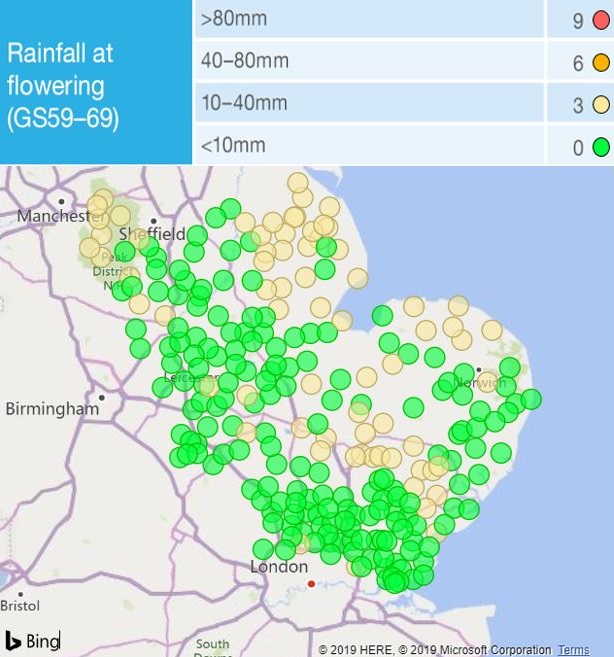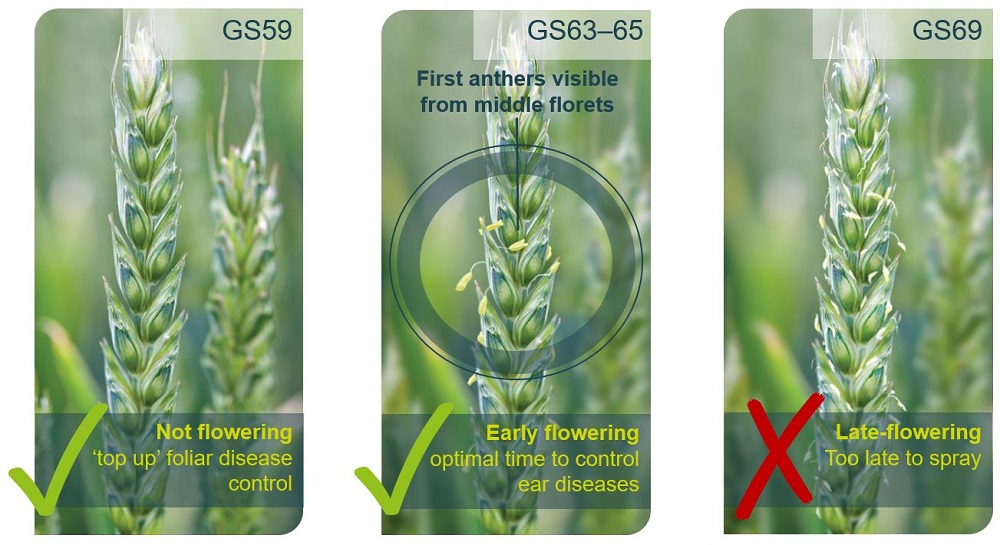Resources issued to guide management of mycotoxin risks
Friday, 31 May 2019
Rainfall-related mycotoxin risk assessment scores can now be calculated automatically, thanks to a new tool issued by AHDB.
Covering thousands of sites across England and Scotland, the map-based tool also shows how much rain has fallen during the critical winter wheat flowering and pre-harvest periods.
Guidance on how to target T3 fungicide sprays during flowering has also been issued.
Dr Dhan Bhandari, who manages grain quality research at AHDB, said: “The pathogens that cause head blight are spread by rainfall. If they reach the ear at the right growth stage, they can infect it. Once infected, some of these species produce mycotoxins – so it’s important that they are managed. The new tool can help people quantify the rainfall risk during the flowering and pre-harvest periods.”
In winter wheat, the first risk period is during flowering – GS59 (ear completely emerged above flag leaf ligule) to GS69 (flowering complete). As infection occurs via fresh anthers (i.e. not dry, light-coloured and falling off), the duration they are present is critical – this period rarely exceeds 10 days. The second key rainfall risk period is GS87 (hard dough, thumbnail impression held) to harvest.
Once the date range is known for each period, it can be entered into the AHDB rainfall tool. The amount of rain that fell during this time is then calculated at each site and the corresponding risk scores shown. If no field-level rainfall data is available, risk scores from a nearby site can help guide the completion of the AHDB mycotoxin risk assessment.
Wet conditions at flowering not only increase ear-infection risk but also make the application of fungicides a challenge. For the management of ear diseases, sprays should be applied when the first anthers are visible (GS63–65). The effective window for control is narrow and the power of a T3 diminishes rapidly after the optimum spray timing. To improve the targeting of T3 sprays, AHDB has issued a pictorial guide.
Paul Gosling, who manages fungicide performance at AHDB, said: “A T3 should not be a default in any wheat fungicide programme. If it is dry when anthers are out, then the disease pressure is unlikely to warrant the spray. However, if a T3 is considered necessary, azoles should be combined with a multisite to help protect the azole from resistance. A multisite will also provide added septoria control.”
Information on mycotoxin management, T3 timing and fungicide performance can be accessed via: ahdb.org.uk/mycotoxins
Notes to editors
As part of the mycotoxin risk assessment, it is essential to understand rainfall-related risk. To calculate a final risk score, other influential factors also need to considered. These are region, previous crop, cultivation approach, varietal disease resistance rating and T3 fungicide dose. The risk assessment does not take account of fungicide timing. A final risk score must be entered onto the combinable crops passport.
Rainfall tool
 AHDB
AHDB
A screenshot of the mycotoxin rainfall risk tool (East of England region selected). Coloured circles indicate the rainfall-related mycotoxin risk scores for a defined flowering period.
T3 timing

A T3 fungicide spray can help ‘top-up’ foliar disease control or control fusarium and microdochium species that cause the ear disease head blight. The disease target alters the optimum time for the T3 spray.
Timing T3 sprays in winter wheat (publication)
Download the image of winter wheat at GS63-G65.
Images courtesy of Bayer Crop Science.
Topics:
Sectors:
Tags:

